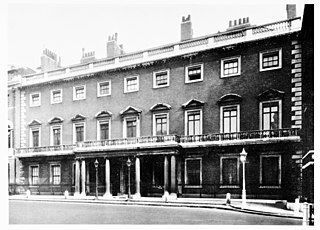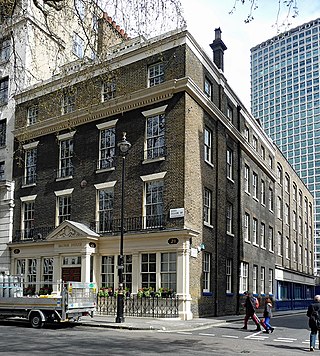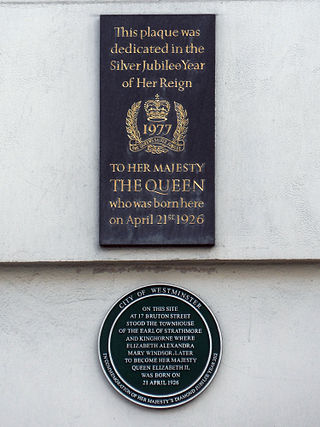Related Research Articles

Clan Campbell is a Highland Scottish clan, historically one of the largest and most powerful of the Highland clans. The Clan Campbell lands are in Argyll and within their lands lies Ben Cruachan. The chief of the clan became Earl of Argyll and later Duke of Argyll.

Duke of Argyll is a title created in the peerage of Scotland in 1701 and in the peerage of the United Kingdom in 1892. The earls, marquesses, and dukes of Argyll were for several centuries among the most powerful noble families in Scotland. As such, they played a major role in Scottish history throughout the 16th, 17th, and 18th centuries. The Duke of Argyll also holds the hereditary titles of chief of Clan Campbell and Master of the Household of Scotland.

Great Marlborough Street is a thoroughfare in Soho, Central London. It runs east of Regent Street past Carnaby Street towards Noel Street.

Rutland House was the name of at least three London houses occupied by the Earls and Dukes of Rutland. That on Aldersgate Street was leased by playwright Sir William Davenant, who converted a room of it into a private theatre in the 1650s. That in Knightsbridge was a six-acre site until its demolition in the 1830s. The third is located on Park Place in St James's.

Norfolk House was the London residence of the Howard family headed by the Dukes of Norfolk, and as such more than one building has been given this name. The first was opposite Lambeth Palace, set in acres of garden and orchards on a site occupying what is now the Novotel London Waterloo on Lambeth Road.

Thomas Belasyse, 1st Earl Fauconberg PC was an English peer. He supported the Parliamentary cause in the English Civil War, becoming close to Oliver Cromwell and marrying Cromwell's third daughter, Mary. After the Restoration of the monarchy he became a member of the Privy Council to Charles II and was elevated to an earldom by William III.

Gloucester Road is a street in the Royal Borough of Kensington and Chelsea, London. It runs north–south between Kensington Gardens and Old Brompton Road.

Essex House was a house that fronted the Strand in London. Originally called Leicester House, it was built around 1575 for Robert Dudley, 1st Earl of Leicester, and was renamed Essex House after being inherited by his stepson, Robert Devereux, 2nd Earl of Essex, after Leicester's death in 1588. The poet Philip Sidney lived in Leicester House for some time.

Adelphi is a district of the City of Westminster in London. The small district includes the streets of Adelphi Terrace, Robert Street and John Adam Street. Of rare use colloquially, Adelphi is grouped with Aldwych as the greater Strand district which for many decades formed a parliamentary constituency and civil registration district.

Manor House, 21 Soho Square is a Grade II listed building in the West End of London. It has 17th-century origins but the existing structure dates from 1838. It was originally built in 1678 as a townhouse but through its history has also been a notorious brothel, the headquarters of Crosse & Blackwell and is now an office building.

Ashtead Park is a 24.2-hectare (60-acre) Local Nature Reserve in Ashtead in Surrey. It is owned by Mole Valley District Council. It contains several important listed buildings. The Park itself has remains of a Roman building, four lakes/ponds and the school's playing fields and is Grade II listed on the Register of Historic Parks and Gardens.

Ashley Park is a private residential neighbourhood at Walton-on-Thames in Surrey. Its central feature was a grandiose English country house, at times enjoying associated medieval manorial rights, which stood on the site, with alterations, between 1605 and the early 1920s. Its owners included Charles Sackville, 2nd Duke of Dorset, in the 18th century and members of the Sassoon family around the turn of the 20th century.

Ealing Grove was a mansion and estate in Ealing, Middlesex, west London, England. It was adjacent to the Ealing House estate, but distinct from it, and stood amongst trees.
Harcourt House was a palatial residence built in about 1722 by Thomas Archer on Cavendish Square. The main structure was largely demolished in 1906 leaving only the southern wing on the corner with Margaret Street, now Flanders House. The southern wing of the building survives today as 1A Cavendish Square.

Twickenham Meadows, later known as Cambridge Park, was a 74-acre estate, the second largest estate in Twickenham, England, after Twickenham Park. It has now been built over and the name remains for a part of Twickenham in optional – station-centric terms – considered St Margarets. The estate included a three-storey brick Jacobean mansion which was built around 1610 and was later known as Cambridge House. The house was demolished in 1937
Kensington House was an academy established by 1756 in Kensington, London, England. The school was operated by a variety of people until about 1813 or 1815. After being operated as a Catholic boarding house from 1815 to 1825, it was the site of a private asylum beginning in 1830.

Leicester House was a large aristocratic townhouse in Westminster, London, to the north of where Leicester Square now is. Built by the Earl of Leicester and completed in 1635, it was later occupied by Elizabeth Stuart, a British princess and former Queen of Bohemia, and in the 1700s by the two successive Hanoverian princes of Wales.

Bruton Street is a street in London's Mayfair district. Queen Elizabeth II was born there, and the fashion designer Norman Hartnell lived there for 44 years.

Little Sutton was one of the four constituent medieval villages of Chiswick, in what is now West London, and the site of a royal manor house, Sutton Manor, later Sutton Court. The great house was accompanied by a small hamlet without a church of its own.

Beaufort House was a grand mansion built beside the River Thames at Chelsea, London, by Thomas More in about 1520, while he held the position of Lord High Chancellor of England to King Henry VIII. On his arrest in 1534 all of More's property was forfeit to the Crown. The house was given the name of Beaufort House only in 1682, when it passed into the hands of the 1st Duke of Beaufort. It was demolished in 1740, giving its name to present-day Beaufort Street.
References
- 1 2 3 4 5 6 7 8 Christopher Hibbert Ben Weinreb; John & Julia Keay (9 May 2011). The London Encyclopaedia (3rd ed.). Pan Macmillan. pp. 287–. ISBN 978-0-230-73878-2.
- ↑ John Heneage Jesse (1871). London: its celebrated characters and remarkable places. Richard Bentley , publisher in ordinary to her majesty. pp. 326–.